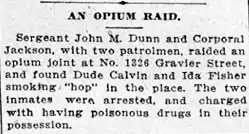International Opium Convention
The International Opium Convention, signed at The Hague on January 23, 1912 during the First International Opium Conference, was the first international drug control treaty. The United States was unsuccessful in its attempts to have cannabis included in the 1912 Convention.[1]It was registered in League of Nations Treaty Series on January 23, 1922.[2] The United States convened a 13-nation conference of the International Opium Commission in 1909 in Shanghai, China, in response to increasing criticism of the opium trade. The treaty was signed by Germany, the United States, China, France, the United Kingdom, Italy, Japan, the Netherlands, Persia, Portugal, Russia, and Siam. The Convention provided, "The contracting Powers shall use their best endeavours to control, or to cause to be controlled, all persons manufacturing, importing, selling, distributing, and exporting morphine, cocaine, and their respective salts, as well as the buildings in which these persons carry such an industry or trade."
 Opium article from The Daily Picayune, February 24, 1912, New Orleans, Louisiana | |
| Signed | January 23, 1912 |
|---|---|
| Location | The Hague |
| Effective | February 11, 1915 / June 28, 1919 |
The Convention was implemented in 1915 by the United States, Netherlands, China, Honduras, and Norway. It went into force globally in 1919, when it was incorporated into the Treaty of Versailles. The primary objective of the convention was to introduce restrictions on exports as opposed to imposing prohibition or criminalising the use and cultivation of opium, coca, and cannabis. That explains the withdrawal of the United States and China, which were gravitating towards prohibitionist approaches, as well as the beginning of negotiations leading to the 1925 International Opium Convention in Geneva.[3]
A revised International Opium Convention International Convention relating to Dangerous Drugs was signed at Geneva on February 19, 1925, which went into effect on September 25, 1938, and was registered in League of Nations Treaty Series on the same day.[4][5] It introduced a statistical control system to be supervised by a Permanent Central Opium Board, a body of the League of Nations. Egypt, with support from China and United States, recommended that a prohibition on hashish be added to the Convention, and a sub-committee proposed the following text:
The use of Indian hemp and the preparations derived therefrom may only be authorized for medical and scientific purposes. The raw resin (charas), however, which is extracted from the female tops of the cannabis sativa L, together with the various preparations (hashish, chira, esrar, diamba, etc.) of which it forms the basis, not being at present utilized for medical purposes and only being susceptible of utilisation for harmful purposes, in the same manner as other narcotics, may not be produced, sold, traded in, etc., under any circumstances whatsoever.
India and other countries objected to this language, citing social and religious customs and the prevalence of wild-growing cannabis plants that would make it difficult to enforce. Accordingly, this provision never made it into the final treaty. A compromise[6] was made that banned exportation of Indian hemp to countries that have prohibited its use, and requiring importing countries to issue certificates approving the importation and stating that the shipment was required "exclusively for medical or scientific purposes." It also required Parties to "exercise an effective control of such a nature as to prevent the illicit international traffic in Indian hemp and especially in the resin." These restrictions still left considerable leeway for countries to allow production, internal trade, and use of cannabis for recreational purposes.[7]
The Convention was superseded by the 1961 Single Convention on Narcotic Drugs.
See also
References
| Wikisource has original text related to this article: |
- The beginnings of international drug control, UN Chronicle, Summer, 1998.
- International Opium Convention Signed at The Hague January 23, 1912.
- "UNODC - Bulletin on Narcotics - 1962 Issue 4 - 004". United Nations : Office on Drugs and Crime. Retrieved 2021-01-23.
- League of Nations Treaty Series, vol. 8, pp. 188-239.
- A Primer on the UN Drug Control Conventions. Transnational Institute.
- League of Nations Treaty Series, vol. 81, pp. 318-358.
- The beginnings of international drug control
- W.W. WILLOUGHBY: OPIUM AS AN INTERNATIONAL PROBLEM, BALTIMORE, THE JOHNS HOPKINS PRESS, 1925
- The cannabis problem: A note on the problem and the history of international action Archived 2005-05-26 at the Wayback Machine
External links
- Text of the 1912 convention
- Text of the 1925 convention
- Signatures and ratifications.
- "The 1912 Hague International Opium Convention". United Nations Office on Drugs and Crime. January 23, 2009.
- Opium Museum
- A primer on the UN Drug Control Conventions Transnational Institute.
- Losing Ground: Drug Control and War in Afghanistan Transnational Institute.